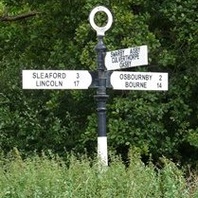
Viking Names
Aswarby
Aswarby, in the Aswardhurn Wapentake of Lincolnshire, is a compound name formed from the Old Norse male personal name Ásvarðr and Old Norse by ‘a farmstead, a village’. The construction of the place-name is identical with that of Aswardby, in the South Riding of Lindsey in Lincolnshire. Ásvarðr is also the first element in the district name, Aswardhurn, and presumably both the settlement and the district names refer to the same man. Aswarby is now a joint parish with Swarby.
Read More
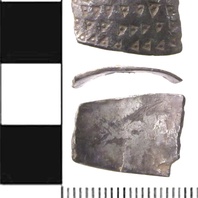
Viking Objects
Silver Arm Ring Fragment (SWYOR-58AFB4)
A fragment of an Early Medieval silver decorated arm ring with triangular punches each with a pellet in the centre. The object may represent hacksilver, but as it is broken rather than cut, this is not certain. Nonetheless, arm rings functioned as both a means of storing wealth as well as putting the wealth and status of the individual on display.
Read More
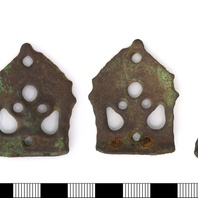
Viking Objects
Stirrup Mount (LEIC-113224)
Early medieval copper-alloy stirrup mount rectangular in form and cross section. The main decoration consists of a trilobed motif, cebntrally placed, which sits on a very short wide shaft running to the objects base. The mount is classified under Williams class B, type 1, group 3.
Read More
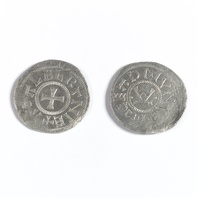
Viking Objects
Reproduction Viking Silver Penny
This reproduction of a Viking silver penny immitates those minited bu the Vikign rulers of York in the tenth century. Viking rulers in the Danelaw eventually took up the Anglo-Saxon practice of minting coins which helped legitimise their authority.
Read More
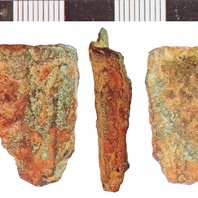
Viking Objects
Scabbard Chape (NLM-6C0242)
This possible scabbard chape fragment is very damaged but the reddish tint is often characteristic of Anglo-Scandinavian metalwork
Read More

Viking Names
Thormund
Þormundr is probabably an Eastern Scandinavian make personal name formed from Old Norse Þór- ‘the god’s name Þór’ and Old Norse –mundr ‘protector’. It is rare in Sweden, but a number of instances are recorded in Denmark including the form þurmutʀ in a runic inscription from the early Viking Age. The name was not found in West Scandinavia until the sixteenth century. Some forms of the place-name Thurmaston, Leicestershire seemed to be influenced by Þormundr in the thirteenth and fourteenth centuries.
Read More
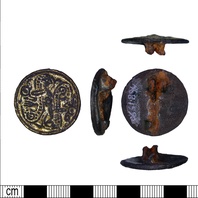
Viking Objects
Copper-Alloy Jellinge-Style Brooch (LEIC-36241D)
This brooch contains two S-shaped zoomorphic Jellinge-style designs around a central boss. For more information on Scandinavian jewellery in England check out our blog: Brooches, Pendants and Pins: Scandinavian Dress Accessories in England.
Read More
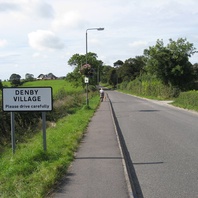
Viking Names
Denby
Denby, in the Morleyston and Litchurch Hundred of Derbyshire, takes its name from the Old English ethnonym Dene ‘a Dane’ and Old Norse by ‘a farmstead, a village’. Traditionally, the place-name has been interpreted as referring to a settlement of Danes. However, the exact implications of such a name are not yet fully understood and are the subject of ongoing work by Dr Jayne Carroll of the Institute for Name-Studies, University of Nottingham.
Read More
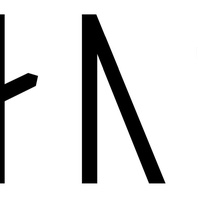
Viking Names
Gauti
Gauti and the related Gautr are short forms of names in Gaut- or -gautr, or an original byname meaning ‘man from Gautland’. This region comprises the provinces now known as Östergötland and Västergötland in southern Sweden, and is the homeland of the Geats in the Old English poem Beowulf. Gauti is recorded in several Swedish runic inscriptions. Gauti is the first element of the place-names Gautby, Lincolnshire and Goadby Marwood, Leicestershire.
Read More
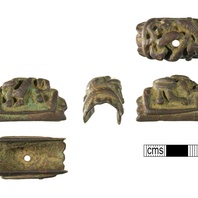
Viking Objects
Urnes-Style Sword Mount (WMID-2FF927)
A cast copper-alloy fitting with Urnes-style, zoomorphic decoration, found near Boylestone, Derbyshire. It may have been a pommel mount and, if so, would have showed off the wealth of the owner.
Read More
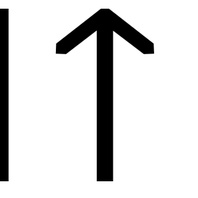
Viking Names
Ketil
The Old Norse male name Ketill is widely used across the Scandinavian world, including the Viking diaspora. It is also common as an element in compound names such as Grímketill (in later times usually appearing in a reduced form as Grímkell) or Ketilbjörn. In place-names it occurs for example in Kedleston, Derbyshire, Ab Kettleby, Leicestershire and several names in Lincolnshire such as Ketsby and Kettlethorpe. The name is identical to the common noun ketill meaning ‘kettle, cauldron’, which is a loan-word from Latin catillus (a ‘small basin’ or ‘bowl’) in Germanic languages. This suggests it was originally a by-name and there are many suggestions as to how such a by-name might have come about, including because someone had a head shaped like a cauldron, or wore a cauldron-shaped helmet, or engaged in ritual activities using a cauldron. In any case, by the Viking Age it is well established as a given name, without obvious reference to its meaning. The element is frequent in the Danelaw, both as a name and as the first element of place-names. Occasionally, the place-names may contain the Old English cognate cetel/cietel/cytel, used topographically for a deep valley surrounded by hills, and often associated with springs or streams. Its use as a personal name, however, seems to have been introduced by the Scandinavians.
